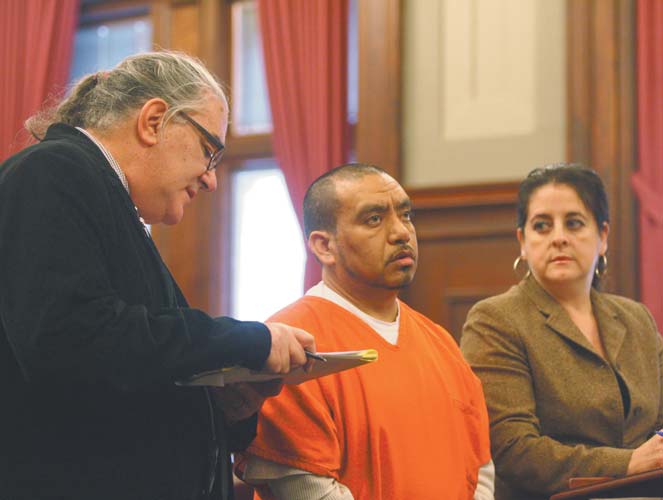Courtroom interpreters remain neutral

State-certifi ed English-Spanish interpreter John P. Shaklee, left, interprets for Victor Manuel Galindo-Barjas, a native Spanishspeaker from Mexico, during a court hearing in which Barjas pleaded guilty to drunken driving and two counts of aggravated vehicular assault. At right is Barjas’ lawyer, Miriam Ocasio. Costs for interpreters have been low. A5.
RELATED: Costs for interpreters have been ‘minimal’
YOUNGSTOWN
The work of John P. Shaklee, a state-certified courtroom interpreter, is characterized by neutrality, unobtrusiveness, speed and precision.
Like his colleagues at the United Nations and other diplomatic venues, the English-Spanish interpreter is one of a rare breed of people capable of listening in one language and simultaneously talking in another in an official proceeding.
Nowhere are these professional characteristics more essential than in the courtroom, where a defendant’s liberty, and sometimes his life, are at stake in a criminal case.
“We say exactly what they say,” said Shaklee of North Canton, who has a master’s degree in translation from Kent State University and has been doing courtroom interpretation and translation for 16 years.
Shaklee and his colleagues, who are certified by written and oral examination, will be in high demand as the courts prepare for a new Ohio Supreme Court standard taking effect Jan. 1, 2013, that will require certified language or sign-language interpreters for those who need them in all Ohio courts, if such an interpreter is available.
For Ohio courts, there are now 22 Ohio Supreme Court-certified Spanish interpreters, four for Russian, two each for Mandarin Chinese and American Sign Language for deaf people; and one each for Somali and Arabic.
The state’s top court announced the new standard in July 2011, but delayed its effective date until 2013, to allow additional time for more interpreters to become certified.
“They do not work for the state. They do not work for the defense. Their role is to accurately interpret what is said in the courtroom,” said Judge John M. Durkin of Mahoning County Common Pleas Court.
Shaklee has interpreted recently in two major criminal cases before Judge Durkin.
One was the October jury trial, in which David Figueroa was acquitted of the April 2010 murder of Emmanuel Izquierdo.
There, Shaklee and another state-certified interpreter, Ana Gallardo of Fairview Park, sat at the defense table, taking turns providing a simultaneous interpretation from English to Spanish into a microphone as Figueroa listened through headphones.
The new Ohio Supreme Court standard calls for two interpreters in any court proceeding likely to last longer than two hours.
The other proceeding before Judge Durkin for which Shaklee is interpreting is the pending case of Victor Manuel Galindo-Barjas, a native Spanish-speaker from Mexico. Barjas is facing up to 10 years in prison after he pleaded guilty to two counts of aggravated vehicular assault and one count of drunken driving in a crash July 25 on Western Reserve Road, in which two college students were seriously injured.
Having read Barjas’ plea agreement in advance, Shaklee sat at the defense table before court in November and interpreted from English to Spanish as Barjas’ lawyer, Miriam Ocasio, reviewed the plea agreement with him.
During the plea hearing, Shaklee stood next to Barjas and interpreted into his ear as Judge Durkin slowly explained, line by line, the trial rights Barjas would be waiving by pleading guilty.
Shaklee’s voice was barely audible to anyone in the courtroom other than Barjas.
After court, Shaklee interpreted during Barjas’ intake interview for his pre-sentence investigation. Shaklee will return to interpret when Barjas is sentenced at 10 a.m. Jan. 27.
Ocasio, who is Puerto Rican and is fluently bilingual in English and Spanish, and also has done courtroom interpretation, said Shaklee was accurate and “doing a very good job.”
“It’s of vital importance that the defendant knows his constitutional and statutory rights,” Ocasio said. “That’s why it’s really important that the interpreter interprets word for word.”
Jennifer McLaughlin, the assistant county prosecutor handling the Barjas case, said having a state-certified interpreter is a good idea from a prosecutor’s perspective because it eliminates the likelihood of an appeal from a non-English speaking defendant on the grounds that the defendant didn’t understand the court proceedings.
Besides Mahoning County, Shaklee has performed court interpretation and translation in Trumbull, Columbiana, Stark, Tuscarawas, Cuyahoga and Athens counties.
He also does interpretation and translation for hospitals, industries and conferences and over the telephone.
 43
43
